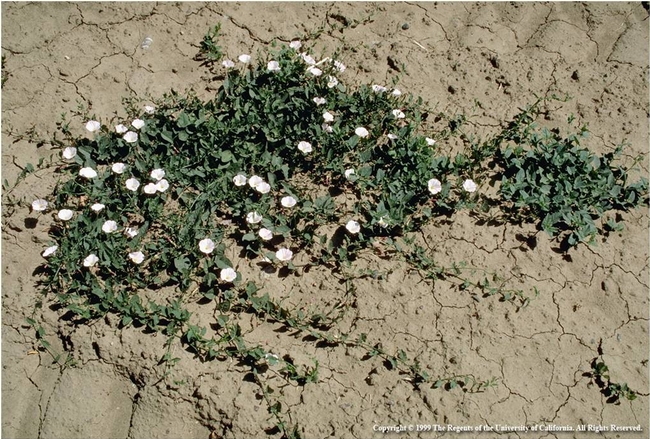Field Bindweed (Convolvulus arvensis)
The late spring rains that fell in Northern California seemed to benefit some plants more than others. One weed that appears to be doing very well this year is Field bindweed. Field bindweed (Convolvulus arvensis), is a perennial weed that spreads by seed, creeping roots and rhizomes. You may call it morningglory or wire weed. It has arrow-shaped leaves and white to pink trumpet-shaped flowers and can grow spread along the ground from early spring until late fall. Bindweed’s creeping roots can penetrate the soil to more than 10 feet and send up vertical shoots that look much like seedlings, but unlike seedlings, are part of a much larger plant. Studies have shown seeds will germinate in a field more than 20 years after the top growth was eradicated. Research done at UC Davis nearly a century ago showed that root and rhizome growth can reach 2.5 to 5 tons/acre and that 12% of that weight is food reserve, while other studies have shown that 70% of this biomass is all within the top 2 feet of soil.

How to control it? There is no easy answer except to keep it from ever becoming established in your field. Once established it will take several years to control. As Dr. Tom Lanini, Weed Ecologist at UC Davis said, “the part of the bindweed plant you see is just the tip of the iceberg.” You must understand the biology of this weed to have a chance of controlling it. Bindweed’s extensive underground root system make it very drought tolerant. It is much more tolerant than most annual crops, or annual weeds, and because of this may spread even more during years with low rainfall. Bindweed does well in open areas, or where it can grow over other plants. Growing competitive plants, especially those that will shade the bind weed may help reduce the spread.
The best strategy for control is a combination of chemical and cultural methods. Weeds of California and Other Western States suggests that the management practice of “deep cultivation before flowering and repeated cultivation when new shoots appear for one to several years followed by rotation to a competitive crop such as winter wheat or alfalfa can control troublesome infestations in agricultural fields.” In perennial crops this suggests that covercrops may help suppress bindweed.
When using herbicides, timing is extremely critical. The use of contact herbicides at any time, or glyphosate in early spring will only kill the above ground portion of the plant. Glyphosate applications should be made in late spring to summer after flowering has begun. At this time the majority of the plants resources (and the herbicide) are being sent to root and rhizome growth, but seeds have just begun to be produced. Water stress will reduce the movement of sugars (photosynthates) and therefore systemic herbicides, reducing their efficacy. If the soil is very dry it may be necessary to irrigate to get good control of bindweed. The combination of these factors will increase herbicide movement down in the plant and enhance efficacy. If bindweed eradication is your goal, plan on making a long-term commitment.
For more information, please see the UCIPM Pest Note on Field bindweed: http://www.ipm.ucdavis.edu/PMG/PESTNOTES/pn7462.html